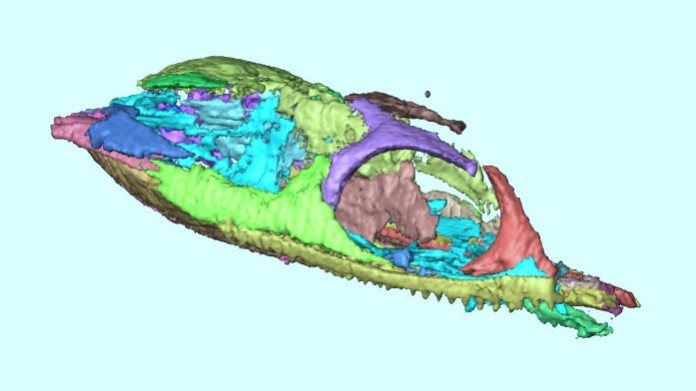In 1998, Jason Anderson studied the only known fossil of Lethiscus stocki – a snake-like creature that appeared early in the transition from fish to four-legged animals, about 340 million years ago. Unfortunately, the fossil was also encased in a hardened mineral shell that kept many of its mysteries hidden.
“I was frustrated because I knew there was more there to be seen,” says Anderson, who is now a Professor in Comparative Biology and Experimental Medicine (CBEM) at the University of Calgary.
It took almost 20 years for technology to catch up to Anderson’s ambition, but, along with an international team of researchers, he was finally able to study that same Lethiscus stocki specimen in more detail. The surprising results of the study were published in Nature last week.
From sea to land
Four hundred million years ago, fish began to evolve into four-legged creatures that could live on land. These creatures are collectively called tetrapods, and they include all living and extinct amphibians, reptiles, birds, and mammals. Exactly how this transition from fish to tetrapod occurred is still an active area of research and species like Lethiscus stocki that lived around this time can provide valuable information.
“[Lethiscus is also] the first tetrapod fossil found after a global hiatus in the fossil record, making it very important for our overall understanding of tetrapod evolution,” explains Anderson.
Given its highly specialized, snake-like anatomy, Lethiscus had been categorized as one of the first descendants of the last common ancestor of our living animals – like a great-great-grand uncle. But the picture formed after Anderson and his team performed a micro-computer tomography (CT) scan of the Lethiscus fossil tells a different story: the internal anatomy of Lethiscus is more similar to fish than reptiles or amphibians, suggesting that it falls much earlier in the evolutionary lineage.
“I was beyond excited!” says Anderson. “Finally, after nearly 20 years, I was able to see what it was like.”
Evolutionary experimentation
This new information forces a dramatic change in the way most researchers think about the transition from fish to tetrapods. Rather than being slow, with fins gradually being replaced by limbs, Lethiscus shows immediate and drastic anatomical changes.
After a more detailed anatomical description of this fossil, Anderson intends to study other early tetrapods as well.
“With CT we can finally see inside the heads of these animals, and it’s very important information to consider.”
The team was also amazed to find evidence of some soft tissues preserved within the hard mineral shell. It seems this Lethiscus stocki fossil still has many more stories to tell.








































